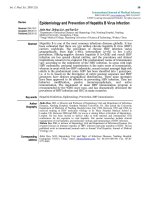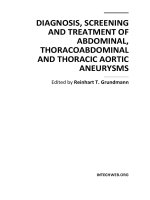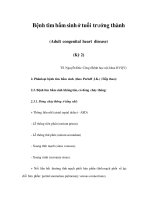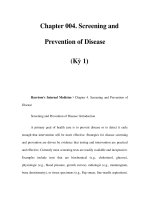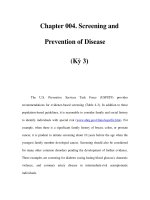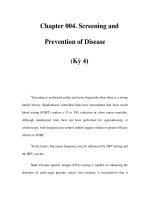Chapter 004. Screening and Prevention of Disease (Kỳ 4) ppsx
Bạn đang xem bản rút gọn của tài liệu. Xem và tải ngay bản đầy đủ của tài liệu tại đây (53.09 KB, 6 trang )
Chapter 004. Screening and
Prevention of Disease
(Kỳ 4)
a
Screening is performed earlier and more frequently when there is a strong
family history. Randomized, controlled trials have documented that fecal occult
blood testing (FOBT) confers a 15 to 30% red
uction in colon cancer mortality.
Although randomized trials have not been performed for sigmoidoscopy or
colonoscopy, well-designed case-
control studies suggest similar or greater efficacy
relative to FOBT.
b
In the future, Pap smear frequency may be influ
enced by HPV testing and
the HPV vaccine.
Note: Prostate-
specific antigen (PSA) testing is capable of enhancing the
detection of early-
stage prostate cancer, but evidence is inconclusive that it
improves health outcomes. PSA testing is recommended by sever
al professional
organizations and is widely used in clinical practice, but it is not currently
recommended by the U.S. Preventive Services Task Force (Chap. 81).
Source:
Adapted from the U.S. Preventive Services Task Force, 2005.
Guide to Clinical Prevention Services
, 3d ed.
Cost-Effectiveness
Screening techniques must be cost-effective if they are to be applied to
large populations. Costs include not only the expense of testing but also time away
from work and potential risks. When the risk-to-benefit ratio is less favorable, it is
useful to provide information to patients and factor their perspectives into the
decision-making process. For example, many expert groups, including the
USPSTF, recommend an individualized discussion about prostate cancer
screening, as the decision-making process is complex and relies heavily on
personal issues. Although the early detection of prostate cancer may intuitively
seem desirable, risks include false-positive results that can lead to anxiety and
unnecessary surgery. Potential complications from surgery and radiation treatment
include erectile dysfunction, urinary incontinence, and bowel dysfunction. Some
men may decline screening, while others may be more willing to accept the risks
of an early-detection strategy. Another example of shared decision-making is the
choice of colon cancer screening techniques (Chap. 78). In controlled studies, the
use of annual FOBT reduces colon cancer deaths by 15–30%. Flexible
sigmoidoscopy reduces colon cancer deaths by ~60%. Colonoscopy offers the
same, or greater, benefit than flexible sigmoidoscopy, but its use incurs additional
costs and risks. These screening procedures have not been directly compared in
the same population, but the estimated cost to society is similar: $10,000–25,000
per year of life saved. Thus, while one patient may prefer the ease of preparation,
less time disruption, and the lower risk of flexible sigmoidoscopy, others may
prefer the sedation and thoroughness of colonoscopy.
When considering the impact of screening tests, it is important to recognize
that tobacco and alcohol use, diet, and exercise comprise the vast majority of
factors that influence preventable deaths in developed countries. Perhaps the
single greatest preventive health care measure is to help patients quit smoking
(Chap. 390).
Commonly Encountered Issues
Despite compelling evidence that prevention strategies can have major
health care benefits, implementation of these services is challenging because of
competing demands on physician and patient time and because of gaps in health
care reimbursement. Moreover, efforts to reduce disease risk frequently involve
behavior changes (e.g., weight loss, exercise, seatbelts) or managing addictive
conditions (e.g., tobacco and alcohol use) that are often recalcitrant to
intervention. Public education and economic incentives are often useful, in
addition to counseling by health care providers (Table 4-4).
Table 4-4 Counseling to Prevent Disease
Topic Chapter
Reference
Tobacco cessation 390
Drug and alcohol use 387, 388
Nutrition to maintain caloric balance and vitamin
intake
54
Calcium intake in women >18 years 318
Folic acid: Women of childbearing age 71
Oral health 24
Aspirin use to prevent cardiovascular disease in
selected men >40 years and women >50 years
235
Chemoprevention of breast cancer in women at high
risk
65
STDs and HIV prevention 124, 182
Physical activity
Sun exposure 57
Injury prevention (loaded handgun, seat belts, bicycle
helmet)
Issues in the elderly 9
Polypharmacy
Fall prevention
Hot water heater <120°
Vision, hearing, dental evaluations
Immunizations (pneumococcal, influenza)
Note: STDs, sexually transmitted diseases.
